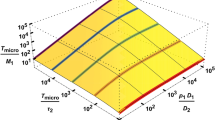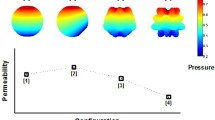Abstract
Diffusion through a flat pore into a large open region is proportional to the linear dimension of the pore and not to its area. This was first explained by Brown and Escombe (1900) for a circular pore and is here generalized, by means of a dimensional argument, to include any type of regular opening. The problem is further generalized to include diffusion through pores of finite thickness, finite distance apart, and into finite regions. Since this problem cannot be solved exactly, an approximation method is introduced. Reasons for the credibility of the approximation are presented. It is then shown, by means of the approximation method, that the diffusive flow through a pore is equal to the total concentration difference divided by the resistance of the system. The resistance, in turn, is the sum of the resistances of all portions of the system, each of which is calculated. The result is compared with results which have been calculated exactly for limiting cases and found to agree very well. The results are then applied to a standard method of computing pore size in membranes, and it is shown that the correction factor is negligible.
Similar content being viewed by others
Literature
Brown, H. T., and F. Escombe. 1900. “Static Diffusion of Gases and Liquids in Relation to the Assimilation of Carbon and Translocation in Plants.”Phil. Trans. Roy. Soc. B,193, 223–91.
Durbin, R. P., H. Frank, and A. K. Solomon. 1956. “Water Flow through Frog Gastric Mucosa.”Jour. Gen. Physiol.,39, 535–51.
Gray, A., G. B. Mathews, and T. M. MacRobert. 1931.A Treatise on Bessel Functions and Their application to Physics. 2d ed. London: Macmillan & Co. Limited.
Koefoed-Johnsen, V., and H. H. Ussing. 1953. “The Contributions of Diffusion and Flow to the Passage of D2O through Living Membranes.”Acta Physiol. Scand.,28, 60–76.
Landahl, H. D. 1953. “An Approximation Method for the Solution of Diffusion and Related Problems.”Bull. Math. Biophysics,15, 49–61.
Meyer, B. S., and D. B. Anderson. 1952.Plant Physiology. 2d ed. New York: D. Van Nostrand Co., Inc.
Pappenheimer, J. R. 1953. “Passage of Molecules through Capillary Walls.”Physiol. Rev.,33, 387–423.
Verduin, J. 1949. “Diffusion through Multiperforate Septa.”Photosynthesis in Plants, ed. J. Franck and W. Loomis, pp. 95–112. Ames, Iowa: Iowa State College Press.
Author information
Authors and Affiliations
Additional information
This research was supported by the United States Air Force through the Air Force Office of Scientific Research of the Air Research and Development Command under Contract No. AF 49(638)-414. Reproduction in whole or in part is permitted for any purpose of the United States Government.
Rights and permissions
About this article
Cite this article
Patlak, C.S. A contribution to the study of diffusion of neutral particles through pores. Bulletin of Mathematical Biophysics 21, 129–140 (1959). https://doi.org/10.1007/BF02476355
Received:
Published:
Issue Date:
DOI: https://doi.org/10.1007/BF02476355




